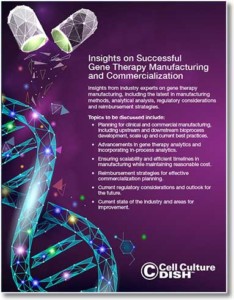
A Remarkable Year for Gene Therapies

“Insights on Successful Gene Therapy Manufacturing and Commercialization”.
You can download all the articles in the series, by downloading the eBook.
Maturing regulatory framework and increasing product and process understanding advances the gene therapy sector.
Amid a chaotic year in many areas, 2020 has been an eventful year for gene therapies—a lot of progress coupled with some setbacks. Notable events so far this year have included a new gene therapy approval, finalization of FDA guidances, FDA striving to manage an increasing number of applications, a widely expected approval not granted, and a trial halted due to patient deaths.
FDA Prepares for Increasing Reviews and Approvals
To date, one gene therapy approval has been granted in 2020, but there are many products in the development pipeline.1 In fact, the FDA hired more than 50 reviewers2 to handle the over 900 new investigational gene or cell therapy drug applications.3 To put this into perspective, the FDA expects to see a doubling of new gene therapy applications every year. In fact, Scott Gottlieb, the former FDA commissioner, predicted that by 2025, the US would be approving between 10 and 20 gene therapies each year.4
US Gene Therapy Regulatory Framework Maturing
In terms of the gene therapy regulatory framework, 2020 has brought a bounty of riches—six guidances were finalized, and a new draft guidance was introduced.
Reflecting the diversity and specificity of gene therapies, some finalized guidances were quite specific—notably addressing hemophilia and retinal disorder. Other final guidance’s confirm issues like long-term follow-up after administration of human gene therapy products and CMC for gene therapy INDs.5 The sector’s developing regulatory maturity will allow the industry and regulators alike to progress quicker and with increased confidence.
High-Profile Rejections Rattle the Industry While Indicating Progress
There has been a reasonably widespread perceived leniency, particularly for the review of one-time therapies for rare diseases. Unexpectedly, BioMarin, the frontrunner in the hemophilia A gene therapy race, was denied approval. Its application for Roctavian included several years of data from a phase 1/2 study and interim results from an ongoing phase 3 study. However, the FDA asked for two years of data from the phase 3 trial to show “substantial evidence of durable effect” on the bleeding rate of trial participants.6
While undoubtedly painful for BioMarin, this rejection signals that the sector’s knowledge base and the understanding of an acceptable gene therapy’s characteristics are advancing. The bar is being raised, signaling gene therapies’ march toward more widespread adoption.
High-dose AAV Toxicity Called into Question
While adeno-associated viral (AAV) vectors have proven to be extremely effective genetic material delivery vehicles, toxicity concerns for high-dosage systemic administration applications are increasing. Despite the setbacks, the industry is committed to working to understand the relationship of high-dose systemic administration of AAV with deadly toxicity.7 Ultimately, given the widespread use of AAV vectors, this increased understanding will benefit the entire gene therapy sector.
Analytical Methods Advancing Despite Ongoing Challenges
Perhaps the most nerve-wracking aspect of gene therapy development is that while product and process understanding and regulatory frameworks are maturing, there are still plenty of unknowns that can vex analytical development. This is not a state that is likely to change; as both the industry and regulators increase their knowledge and experience levels, the bar will continue to rise. A few of the common challenges associated with analytical development are discussed below.
Method Validation
As for other biotherapeutics, gene therapy process validation requirements are well defined, and the process performance qualification (PPQ) protocol includes predetermined acceptance criteria. However, it is difficult to set acceptance criteria due to limited manufacturing data and the possibility of method variability.
In addition, many methods, such as titer, are rushed through development and validation because of the aggressive timelines associated with a breakthrough therapy. Often, they are not fully developed to prevent high levels of variability. Further adding to validation challenges is that as process and product knowledge increase, methods are being further optimized or redeveloped in tandem with PPQ. However, these optimization efforts sometimes result in failure of predefined acceptance criteria. In other cases, due to the known variability of the method, the acceptance criteria are set so wide that it raises questions as to the correlation of the actual specification with clinical experience.
Notable Gene Therapy Method Validation Challenges
In Vitro Potency is the largest method development challenge gene therapy developers face. Per the FDA guidance, the established method must reflect the product’s relevant biological properties: the ability to transfer the gene (infectivity) and the biological effect of the expressed genetic sequence (potency).8 For many gene therapies, the mechanism of action is not fully understood; therefore, the downstream impact of the expressed gene is not known. This makes it incredibly difficult to generate a consistent potency method.
Detection of host cell protein (HCP) impurities can be a stumbling block largely because many companies are not developing in-house methods. Rather, they are using commercially available kits that are eventually discontinued due to kit depletion. As a result, the next generation kit may result in major changes to the detectability and/or sensitivity of the results. Also, as they evolve, HCP kits’ sensitivity can increase reflecting higher residual HCP levels—resetting specifications and additional method validation can result.
Cell-based assays, such as in vitro potency or infectivity, always include inherent variability due to the nature of the cells. To reduce variability, many companies are increasing the n for the number of independent assays or independent samples run under the same operating conditions to achieve one reportable result. A n=3 is becoming the standard to decrease the variability.
The empty to full capsid ratio has been yet another consistent challenge. Some companies initially rely on two highly variable methods, vector genome (vg) titer and capsid titer, to calculate the empty to full capsid ratio. Due to the inherent variability in each method, the variability in the final reportable result is compounded. For example, if the determined vg titer is at the lower end of the specification and the capsid titer is at the higher end, the resulting ratio will demonstrate a lower full capsid ratio. As a result of the variability in historical data, many teams are developing new methods such as analytical ultracentrifugation (AUC) to determine the empty to full capsid ratio later in development or even during PPQ.
Analyst to analyst variability due to operator error must be sharply reduced to deliver needed consistency. Avoiding manual manipulation wherever possible is one important measure. For example, electronic cell counters generating consistent results should be used to determine cell concentration rather than manual cell counting. Other sources of analyst to analyst variability include inconsistent or insufficient training and too few analysts.
FDA & Gene Therapy Process Validation
Process validation studies are typically not required for early-stage manufacturing;9 therefore, most IND submissions will not include them. Instead, the FDA asks gene therapy developers to use early-stage manufacturing experiences to evaluate the need for process improvements and to support process validation studies in the future. This said, too many changes cannot be made to the initial process, as initial processes generated the material used in the Phase 1 trial to obtain breakthrough therapy designation.
As challenging as it is, effective validation requires a thorough understanding of the product’s critical quality attributes (CQAs). Additionally, developers need to determine the critical process parameters (CPPs) that will impact the CQAs—a risk-based approach must be employed to identify the most meaningful process control strategy. In addition to gaining a thorough understanding of as many process parameters as possible, a risk-based approach must recognize processes for which understanding and control are lacking.
Critical Quality Attributes (CQA)
To what degree must CQAs and mechanisms of action be understood in order to project likely clinical outcomes? What levels of understanding do developers and regulators need to gain confidence in the product?
These are not easy questions to answer. Although gene therapy development has advanced markedly in recent years, our understanding of structural-function is still evolving. In short, there are still gaps in our knowledge as to why a gene therapy works or does not work. Or more specifically, why one batch has a higher titer and/or has more or fewer empty, partial, or full capsids than the next batch. Despite the observation of promising clinical outcomes, the causes of process variability are not always well understood.
To achieve a sufficient level of understanding and process control, developers must develop assays specific to their gene therapy platforms including vector genome titer, capsid titer, infectivity, HCP, residual DNA, aggregates, etc. Like all product attributes, product characterization must continue to become more robust as product development advances.
Conclusion
The gene therapy sector suffered some setbacks in 2020 including the FDA denying a widely anticipated approval and three deaths in a trial using high-dose AAV vectors. These incidents were humbling reminders that the industry and regulators alike have much work ahead.
However, with now six approved gene therapies in the US and hundreds of products in the pipeline, the gene therapy sector is making tremendous strides. Additionally, the much-needed regulatory framework is rapidly developing. Ultimately, gene therapy developers will continue to make progress in product consistency and understanding so that the life-enhancing and life-saving promises of gene therapies can be realized.
BioTechLogic, Inc. provides regulatory and manufacturing consulting services with strategic and hands-on experience to help clients bring their products to market quickly and successfully by augmenting and optimizing their organization’s resources.
We are a team of professionals with expertise in Project Management, Process Development, Manufacturing, Process Validation, Analytical Testing/Quality Control, Quality Assurance, Regulatory Submissions, Supply Chain Management, and Combination Products.
Footnotes
-
1. US FDA (July 24, 2020). Approved cellular and gene therapy products. Accessed Oct. 9, 2020: Retrieved from www.fda.gov/vaccines-blood-biologics/cellular-gene-therapy-products/approved-cellular-and-gene-therapy-products
-
2. Weintraub, A. (Dec. 19, 2019). Pharma's gene and cell therapy ambitions will kick into high gear in 2020—despite some major hurdles. Accessed Oct 9, 2020: Retrieved from www.fiercepharma.com/pharma/gene-and-cell-therapy-r-d-will-kick-into-high-gear-2020-despite-hurdles-experts-say
-
3. US FDA (Jan. 20, 2020). FDA continues strong support of innovation in development of gene therapy products-News release. Accessed Sept. 9, 2020: Retrieved from www.fda.gov/news-events/press-announcements/fda-continues-strong-support-innovation-development-gene-therapy-products
-
4. US FDA (Jan. 15, 2019). Statement from FDA commissioner Scott Gottlieb, M.D. and Peter Marks, M.D., Ph.D., Director of the Center for Biologics Evaluation and Research on new policies to advance development of safe and effective cell and gene therapies Accessed Sept. 9, 2020: Retrieved from www.fda.gov/news-events/press-announcements/statement-fda-commissioner-scott-gottlieb-md-and-peter-marks-md-phd-director-center-biologics
-
5. raps.org (Jan. 29, 2020). FDA finalizes 6 Gene therapy guidances, unveils a new draft. Accessed Sep. 9, 2020: Retrieved from www.raps.org/news-and-articles/news-articles/2020/1/fda-finalizes-6-gene-therapy-guidances-unveils-a
-
6. Taylor, N. (Aug. 20, 2020). FDA rejection of BioMarin gene therapy raises durability questions. Accessed Sep. 9, 2020: Retrieved from www.biopharma-reporter.com/Article/2020/08/20/FDA-rejection-of-BioMarin-gene-therapy-raises-durability-questions
-
7. Paulk, N. K. (Sep. 2020). Gene therapy: It’s time to talk about high-dose AAV. Accessed Oct. 9, 2020: Retrieved from www.genengnews.com/commentary/gene-therapy-its-time-to-talk-about-high-dose-aav/
-
8. US FDA (Jan. 2011). Potency tests for cellular and gene therapy products final guidance for industry: January 2011. Accessed Sep. 9, 2020: Retrieved from www.fda.gov/regulatory-information/search-fda-guidance-documents/potency-tests-cellular-and-gene-therapy-products
-
9. Preti, R. (Oct. 2016). Process improvement and accelerated CMC development workshop, Cell and Gene Meeting on the Mesa (video recording). Accessed Sep. 9, 2020: Retrieved from www.youtube.com/watch?v=t05tD1UizHk